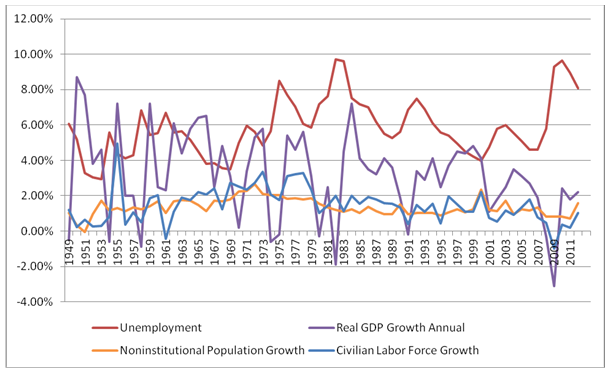Since Dec. 1949 through 2012, the noninstitutional civilian population as measured by the Bureau of Labor Statistics has grown an average 1.35 percent every year, while the civilian labor force has grown even faster at 1.47 percent.
This reflects rising labor participation — the percent of the population either working or looking for work — from a rate of about 59 percent at the beginning of the period to a high of 67.3 percent in 2000. It has since dropped to a recent low of 63.3 percent.
Increased labor participation during this era has largely been driven by women entering the workforce. In Dec. 1949, just 33.5 percent of females were working or seeking work. But by 2000, that figure had jumped to about 60 percent. That compares with the participation rate of men dropping from 86.6 percent to about 70 percent at that time.
A growing labor pool — the labor force growing faster than the population — can often be correlated to periods of robust economic growth. Then, even though labor participation is rising, the unemployment rate is typically dropping, indicating a surplus demand for labor.
When the opposite is true — like today when labor force participation has declined to 63.3 percent, the lowest since 1981 — and fewer people are joining the workforce, it is often during economic slowdowns or recessions.
Which, makes sense. Unemployment usually tends to rise as fewer jobs are available. Except when — like today — so few people are entering the labor force, it artificially tends to keep the unemployment rate lower than it otherwise would be.
Such is the exceptional nature of the U.S. labor market at the moment. Continued declines in labor force participation are an indicator of continued weakness in the overall economy.
To turn things around, the labor force will need to grow consistently faster than the population as a sign of restored health. April’s data shows the noninstitutional population increased by 180,000, and the civilian labor force increased by 210,000, a slight rise in labor participation. Sure enough, the unemployment rate dropped to 7.5 percent as more people entered the work force.
While many commentators often attribute the recent drop in labor force participation to a surge of Baby Boomer retirements, this is not borne out by recent Bureau of Labor Statistics data. For all persons 65 years and older, including those with and without disabilities, labor force participation since June 2008 has actually increased from 16.4 percent to 18.96 percent today.
That despite the fact that the senior population has increased by 5.98 million since then. So, tell us another one.
The real reason labor force participation has been decreasing overall is because younger Americans have not been entering the workforce at the same rate they once did.
For example, the population of those with some college or a college degree 25 years old and older has increased by more than 11 million since 2009, but only 5.1 million have entered the labor force. In the process, the participation rate has declined from 74.9 percent to 72.3 percent, according to data compiled by the Bureau of Labor Statistics.
If the participation rate had just held steady, there would be an additional 3.2 million college-educated young people in the labor force. Critically, the unemployment rate for those with some college and college degrees would be 8.3 percent, instead of the reported 4.95 percent.
Less labor participation for college-educated individuals is particularly a problem because of those with college debt, the average debt total is $20,326. And unless those people work, they will have no way of paying it back. This is already causing higher rates of delinquency.
But worse, it’s leading to a lost generation of opportunity. To get out of this spiral, robust economic growth must be restored, but the policies out of Washington are not designed to do that — they’re merely designed to increase debt. That won’t do the trick anymore.
Overall, the labor market remains incredibly weak, and will likely remain so long as the trend of slow growth and too much debt continues.
Robert Romano is the Senior Editor of Americans for Limited Government.







